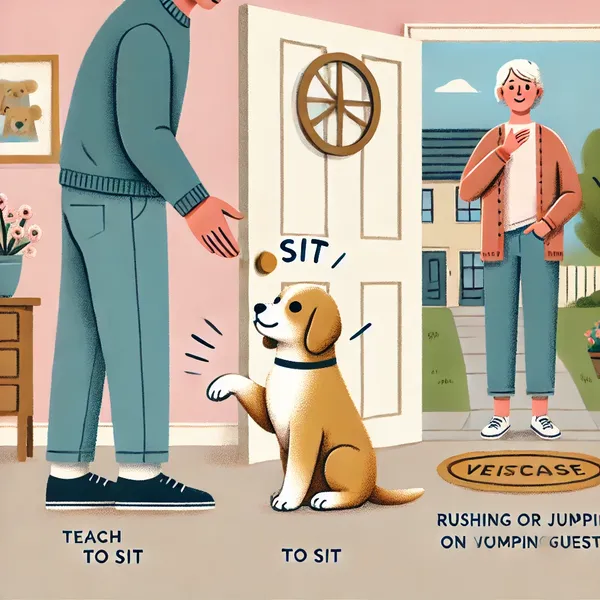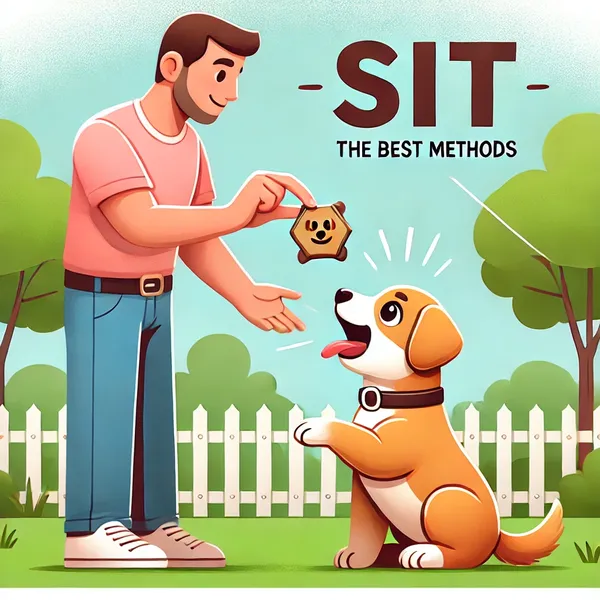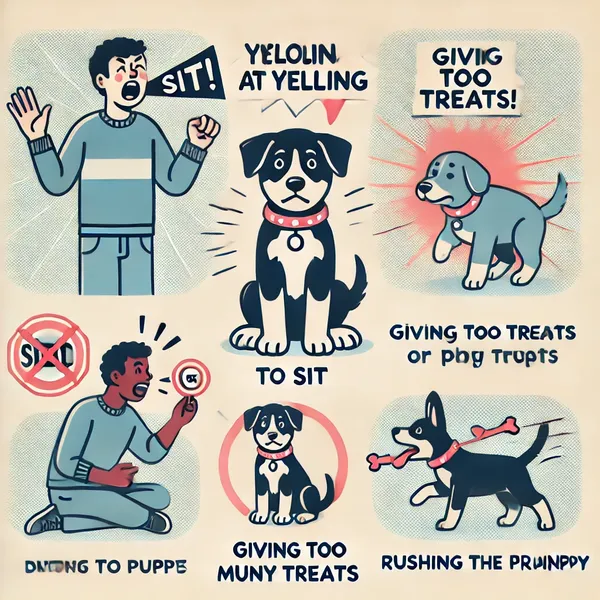What is the best way to train a puppy to sit? Training a puppy to sit is one of the most essential activities for a new pet. It is a fundamental command that helps you control your pet dog and prepares them for future and more advanced training attempts. Puppies pick up skills quickly if the proper methods are applied, but the training must be fun, engaging, and repetitive.
The Step-by-step procedure incorporates simple, direct, and realistic approaches to training a puppy to sit, which anyone can do. Let’s work this out in increments with the assistance of clear illustrations and descriptions.
Why is Teaching “Sit” Important?

Maybe you are one of those people who ask, “Why do I need to make my puppy sit? It is something that every dog eventually does, right?” There is some truth to the fact that most dogs will sit on their own at one time or another, but asking them to do so at will is beneficial for various reasons:
- Discipline: It helps your puppy get the relationship hierarchy, which is quite crucial.
- Prevention: Puppy sitters who sit before getting a treat are easier to handle because they know how to stay still in a risky or sensitive moment.
- Good Mannerism: Sometimes, training a dog to sit helps to prevent the animal from jumping on visitors or rushing out of the door.
License for Future Instruction Integrated: A dog’s ability to follow the “sit” command, for instance, makes possible the following commands: “stay” and “come,” among others.
Best Way to Train a Puppy to Sit

Step-by-step guide to training your puppy to sit:
1. Attract Your Puppy’s Attention
The first focal point is getting the puppy’s attention. Puppies’ attention spans are not very long, so this step is crucial.
Begin with something the puppy likes most, such as food or a toy. Place the treat close to the dog’s nose, but don’t let it take it yet.
Tip: Puppies love excitement, and a cheerful voice is used to engage them.
2. Bring the Treat and Hold it Up before the Dog
At this point, you can move the cookie. Move upwards towards the dog’s nose and then to the top of its head.
As the dog’s nose reaches for the cookie, the puppy’s butt tends to drop to the floor. The instant the puppy’s bottom contacts the ground, use the word ‘ sit’ in a soft but firm voice.
Important: Watch out for the Proper moment! Use the command ‘sit’ when the dog is about to sit and not when he is already sitting.
3. Reward Your Puppy
As soon as your puppy sits, turn into him with the treat and lots of praise and petting! You may yell a weighty line such as “Good boy!” or any other appropriate word.
Puppies are keen on praise, so praising them for sitting on command is advisable.
Example: You can also add some petting or even a belly rub to make the training rewarding to your puppy.
4. Do it Again and Again (Repeat and Practice)
Emphasising repetition is necessary when it comes to training. Run through this process, but try practice sessions once or twice daily, not tiring the puppy for more than 5 minutes.
Keeping the training sessions longer than that tends to distract or bore puppies. Multiple short instructions are recommended rather than a single long instruction.
Key Point: Never give up! The puppy will only succeed sometimes, but things will improve.
Suggestions to Simplify Training
Training puppies is not an easy task, but these pointers will help ease the strain:
1. Embrace the Power of Rewards
Dogs pick up commands better when they anticipate a reward. You cannot tell a young dog not to sit down; instead, you should applaud him when he does it right. This makes the exercise interesting and encourages your puppy to pay attention to you.
2. Avoid Mixing Up ‘Sit’ and its Variants.
The same word and tone should be used every time when making your puppy sit. If you sometimes add extra words such as ‘sit down’ and ‘sit now,’ your puppy may become distorted. To avoid this, use the word sit and nothing else.
3. Train in Different Places
When your dog has learnt to sit down on command at home, practice it in other places – for instance, in the garden or a quiet park.
This way, pups will be encouraged to complete commands in different environments with different attention levels. This should be done periodically.
Common Mistakes to Avoid

Training a puppy is not a walk in the park, and making a few errors is reasonable. Look at the mistakes that people often make and how to avoid them.
1. Not Using Enough Rewards
Initially, you should reward your puppy for sitting every single time, even if it’s by bending down over the dog.
In the later stages, you can reduce the number of treats and offer praise, but in the initial stages, many are needed.
2. Rushing the Training
This is understandable when we say this is training, but it can be pretty discouraging if your puppy does not sit alone.
Nevertheless, there is no point in forcing the training as this may inconvenience you and your pet even more. As difficult as it may be, patience should be exercised, and the dog can learn over time as it wishes.
3. Rebuking Your Puppy
If your puppy can’t immediately follow the command you gave her, don’t be annoyed. There is no need to shout and scold your puppy, for it will only create confusion and might even lead to a loss of interest in training.
Always try to develop trust and self-confidence through the use of positive reinforcement.
Visual Table of Training Steps
| Step | Description |
| Get Attention | Use a treat or toy to grab your puppy’s focus. |
| Lure with Treat | Move the treat over their head so their rear end lowers. |
| Give Command | Say “sit” as they begin to sit. |
| Reward and Praise | Immediately give the treat and praise after they sit. |
| Repeat and Practice | Practice a few times a day, keeping sessions short. |
Training Your Puppy to Sit – When to Start?
Training a puppy to sit can be initiated when the puppy is around eight weeks old. Puppies are like raindrops on lotus leaves; they quickly take new information, especially if they are still young.
It is also advised to initiate training early to help the puppy establish a routine and learn that the owner can give commands.
Did You Know?: Early training of puppies enhances the chances of learning more complicated sequences of actions with time.
How Long It Takes for a Puppy to “Sit.”
Most puppies will understand the command ‘sit’ within a few days to a week of consistent training.
Nonetheless, there is variability in this time frame among puppies. Some may learn in a single day, yet others may take longer due to factors like breed, age, and dog characteristics.
Breed Differences: Patient training can be enough for a breed like a Husky, more self-dependent and less inclined to obey commands than a pouty and obedient Golden Retriever breed, which will learn almost immediately.
Troubleshooting: What if My Puppy Refuses to Sit?
If you have tried encouraging your puppy to sit and he does not cooperate, do not panic. For some dogs, such actions can take time due to stubbornness or distraction. Here are some solutions in case your puppy will not sit:
1. Try to Assess the Setting
Puppy training takes a lot of effort because puppies are great distractions. If your puppy is trained on a leash, find a training ground with fewer distractions, such as noise or movement.
2. Get an Enticing Treat
Now and then, your pet may be tempted by something other than the treats you offer. Using more than just food, lickable treats or temptations such as a small piece of chicken or cheese are sufficient.
3. Get Moving
If a puppy seems uninterested, raise your voice or add excitement by moving around. For example, clap your hands and jump up and down, make a loud noise using a squeaky toy, or do anything else to attract the dog’s attention.
Advanced Tips: Taking the “Sit” Command Further
Now that your puppy has learned and perfected the ‘sit’ command, you can enhance the objectives further through some simple and exciting variations.
1. Sit-Stay
After your puppy has learned to sit confidently, the next step is to teach it to stay still. As soon as they sit, lift your palm like a stop signal and utter, ‘ Stay.’ Proceed to move away gradually. If they do not budge, praise them.
2. Sitting Before Lunch
Moreover, every time lunch is about to be served to the dog, make sure it sits down and waits until told to ‘eat.’
3. Ask Them to Sit Before Taking Them Out
Another rule you can enforce is that your puppy should sit before going outside or wearing their leash. This assists in alleviating them and controlling over-excitement while getting outdoors.
Teaching your puppy the command to sit is more than just learning commands. It is an opportunity for you and your puppy to bond and transform them into a good family member. Remember, it should be fun, one must be extremely patient, and every little success must be appreciated.
Adhering to the steps detailed in this guide and employing positive reinforcement will ensure your puppy will sit like a pro in no time!
Key Takeaway: Don’t expect your puppy to sit on the first command. Staying positive, patient, and practising will ensure your puppy learns to sit when commanded.
Love training your puppy, and don’t forget—that is the enhanced version you are helping to develop!